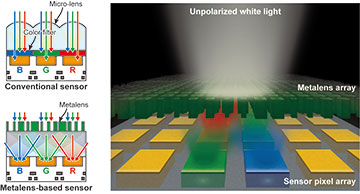Left: Schematic side views of a conventional color image sensor and a metalens-based sensor. Right: An artist’s view of an image sensor with a full-color-sorting metalens array. [Image: Masashi Miyata, NTT Device Technology Labs] [Enlarge image]
From smartphones to autonomous vehicles to wearable devices, imaging sensors are all around us. Now, an innovation in imaging sensors promises to make cameras better at ultrafast imaging in low-light conditions (Optica, doi:10.1364/OPTICA.444255).
Researchers in Japan have developed what they say is an improved sensor component called a pixel-scale metasurface lens. The metasurfaces, which rely on nanostructures to sort light by color, provide a more sensitive way for a sensor to collect light, according to the team.
“Traditional imaging sensors, such as the ones used in smartphones, wearable devices and autonomous vehicles, have a limited sensitivity because they rely on color filters placed over each pixel,” said research team leader Masashi Miyata from NTT Device Technology Labs in Japan in a press release. “Our new metalenses are made from a highly engineered surface that can collect light while simultaneously separating primary colors without any color filters, opening a pathway to dramatically improve sensitivity.”
Dividing up the work
In conventional sensors, color filters reduce incoming light by 70%. The new design can gather all the light by using the metalens to split the light by color and focusing each color onto a different pixel. Thus the new imaging sensors can function in much lower light conditions.
The researchers created metalens arrays by etching a wafer of silicon nitride into tiny posts that split incoming light. The posts then redirect the light onto pixels mounted below, each designated for red, green or blue light.
“Although other pixel-scale color splitters have been experimentally demonstrated, they haven’t been practical for image sensors because they were either inefficient, affected by the light’s polarization or sensitive to light that might hit the sensor from an oblique angle,” Miyata said. “Our metalenses overcame these issues by highly utilizing a dispersion-enriched metasurface platform that makes them polarization-insensitive and suppresses spectral crosstalk for all the color pixels.”
From tests to products
Testing the design with an optical microscope, the researchers found a 2.83-fold increase in sensitivity over a filter-based design. The new design also maintains image quality and resolution.
The construction of the metalenses is also CMOS-compatible, which should help in integrating them onto existing imaging sensors. Furthermore, their design could also help flatten and shrink consumer optics, while enhancing performance, according to the researchers. The team plans to integrate the metalens into a high-performance image sensor that could outperform conventional image sensors.
“An image sensor based on our metalenses has the potential to enable highly sensitive dark-scene or high-speed imaging in a variety of imaging systems,” Miyata said, “which increases the availability of imaging in our daily lives.”

